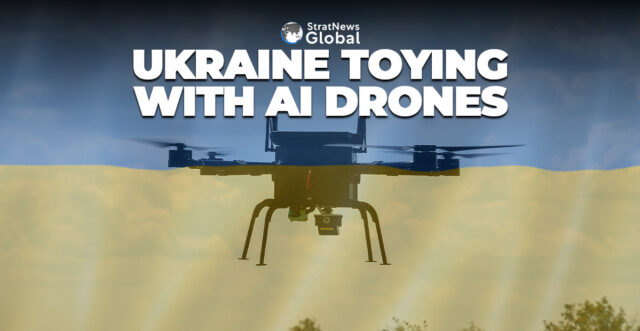In Ukraine, some startups are developing Artificial Intelligence (AI) systems to help fly a vast fleet of drones. The move aims at taking warfare into uncharted territory as combatants race to gain a technological edge in battle.
Ukraine hopes AI-enabled drones across the frontline will help overcome increasing signal jamming by the Russians. It will also enable unmanned aerial vehicles (UAVs) to work in larger groups.
Three-layered Approach
AI drone development in Ukraine is broadly split into three categories. Visual systems help identify targets and fly drones into them. Terrain mapping to aid in navigation. And complex programmes enabling UAVs to operate in interconnected “swarms”.

One company working on this is Swarmer, which is developing software that links drones in a network. Decisions can be implemented instantly across the group, with a human only stepping in to greenlight automated strikes.
“When you try to scale up (with human pilots), it just doesn’t work,” Swarmer CEO Serhiy Kupriienko told Reuters. “For a swarm of 10 or 20 drones or robots, it’s virtually impossible for humans to manage them.”
A Web Of Sorts
Swarmer is one of over 200 tech firms that have sprung up since the Russian invasion in 2022. Civilians from IT backgrounds are developing drones and other devices to help Ukraine counter a much larger enemy.
While human pilots struggled to run operations involving over five drones, AI would be able to process hundreds, said Kupriienko.

The system, called Styx, directs a web of reconnaissance and strike drones, both large and small, in the air and on ground. Every drone would be able to plan its moves and predict the behaviour of others in the swarm, he said.
Automation would scale up operations besides helping protect drone pilots—a priority target for enemy fire. Swarmer’s technology is under development and has only been trialled on the battlefield experimentally.
Ethical Concerns
AI drone control systems would likely need a human to prevent errors in target selection, says Samuel Bendett, Adjunct Senior Fellow at the Center for a New American Security.
There are broad concerns about the ethics of weapons that exclude human judgment. A 2020 European Parliament research paper warned such systems could violate international humanitarian law and lower the threshold of going to war.
AI is already being used in some of Ukraine’s long-range drone strikes targeting military facilities and oil refineries inside Russia. Attacks sometimes involve a swarm of about 20 drones, one Ukrainian official said.
The core drones fly to the target but it’s the job of others to take out or distract air defences along the way. To do this, they use a form of AI with human oversight to help spot targets or threats and plan possible routes.
Signal Jamming
The need for AI-enabled drones is becoming more pressing as both sides roll out Electronic Warfare (EW) systems. Such systems disrupt signals between pilots and drones.
Small, cheap, first person view (FPV) drones used by both sides in 2023 are seeing their hit rates fall as jamming increases.

“We are already working with the concept that in the near future, there will be no connection on the frontline” between pilot and UAV, said Max Makarchuk, the AI lead for Brave1, a defence tech accelerator set up by the Ukrainian government.
High Hit Rates?
According to Makarchuk, most FPV units now see a strike rate of 30-50%, while for new pilots that can be as low as 10%. He predicted that AI-operated FPV drones could post hit rates of around 80%.
Makers including Swarmer have started developing functions which allow a drone to lock onto a target through its camera.
EW systems form an invisible signal-jamming dome over the equipment and soldiers which they protect.
If a pilot’s contact with the drone is cut, they can no longer control it. The craft either drops or continues flying straight on. Automating the final part of a drone’s flight to its target nullifies the effect of jamming.
With inputs from Reuters
At six feet and over, cool, calm and always collected. Never a hair out of place. He is the high priest of editorial facts, grammar is his baby and headlines are meat on the bone. Loves samosas and cricket, tracks Twitter and when in his cups, nothing better than Jagjit Singh’s ghazals.





